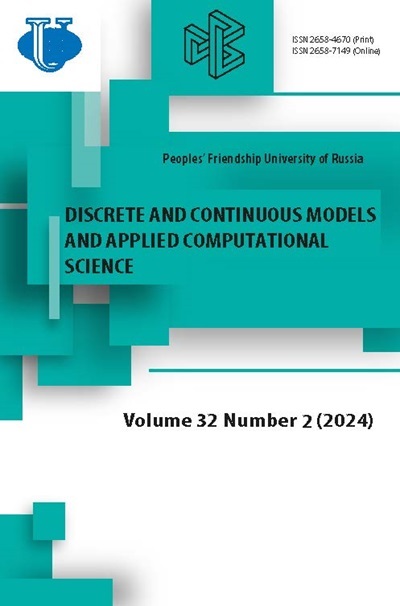О возможности усреднения релятивистских уравнений движения электрона в поле мощного лазерного излучения
- Авторы: Милантьев В.П.1
-
Учреждения:
- Российский университет дружбы народов
- Выпуск: Том 29, № 2 (2021)
- Страницы: 105-113
- Раздел: Статьи
- URL: https://journals.rudn.ru/miph/article/view/26866
- DOI: https://doi.org/10.22363/2658-4670-2021-29-2-105-113
Цитировать
Полный текст
Аннотация
Рассмотрена проблема усреднения релятивистских уравнений движения электрона в поле мощного лазерного излучения, вызванная уменьшением скорости изменения фазы волны из-за эффекта Доплера. Вследствие этого фаза может перейти из числа «быстрых» в число «медленных» переменных движения, так что усреднение по фазе становится невозможным. На основе общих принципов метода усреднения проведён анализ условий, при которых допустимо усреднение уравнений движения по «быстрой» фазе излучения. Лазерное излучение рассматривается в параксиальном приближении, в котором малым параметром является отношение сужения лазерного пучка к рэлеевской длине. Предполагается, что протяжённость импульса сопоставима с порядком сужения лазерного пучка. В этом случае необходимо учитывать поправки первого порядка к векторам поля лазерного импульса. Получен общий критерий, определяющий возможность усреднения релятивистских уравнений движения частицы в поле мощного лазерного излучения. Показано, что усреднённое описание релятивистского движения электрона возможно в случае достаточно умеренной (релятивистской) интенсивности и относительно широких лазерных пучков. Известный в литературе аналогичный критерий был получен ранее на основе численных расчётов.
Об авторах
В. П. Милантьев
Российский университет дружбы народов
Автор, ответственный за переписку.
Email: milantiev-vp@rudn.ru
ORCID iD: 0000-0003-4686-4229
Doctor of Physical and Mathe- matical Sciences, Professor of Institute of Physical Research and Technology
ул. Миклухо-Маклая, д. 6, Москва, 117198, РоссияСписок литературы
- H. Boot and R.-S. Harvie, “Charged particles in a non-uniform radiofrequency field,” Nature, vol. 180, p. 1187, 1957. doi: 10.1038/1801187a0.
- A. Gaponov and M. Miller, “Use of moving high-frequency potential wells for the acceleration of charged particles,” Soviet Physics JETP-USSR, vol. 7, pp. 515-516, 1958.
- T. Kibble, “Mutual refraction of electrons and photons,” Physical Review, vol. 150, p. 1060, 1966. doi: 10.1103/PhysRev.150.1060.
- D. R. Bituk and M. V. Fedorov, “Relativistic ponderomotive forces,” JETP, vol. 89, pp. 640-646, 4 1999. doi: 10.1134/1.559024.
- G. A. Mourou, T. Tajima, and S. V. Bulanov, “Optics in the relativistic regime,” Reviews of Modern Physics, vol. 78, p. 309, 2006. DOI: 10.1103/ RevModPhys.78.309.
- N. M. Naumova, J. A. Nees, and G. A. Mourou, “Relativistic attosecond physics,” Physics of Plasmas, vol. 12, p. 056 707, 2005. DOI: 10.1063/1. 1880032.
- A. V. Korzhimanov et al., “Horizons of petawatt laser technology,” Physics-Uspekhi, vol. 54, p. 9, 2011. doi: 10.3367/UFNe.0181.201101c. 0009.
- C. Danson, D. Hillier, N. Hopps, and D. Neely, “Petawatt class lasers worldwide,” High Power Laser Science and Engineering, vol. 3, 2015. doi: 10.1017/hpl.2019.36.
- L. W. Davis, “Theory of electromagnetic beams,” Physical Review A, vol. 19, pp. 1177-1179, 3 1979. doi: 10.1103/PhysRevA.19.1177.
- B. Quesnel and P. Mora, “Theory and simulation of the interaction of ultraintense laser pulses with electrons in vacuum,” Physical Review E, vol. 58, pp. 3719-3732, 3 1998. doi: 10.1103/PhysRevE.58.3719.
- G. V. Stupakov and M. Zolotorev, “Ponderomotive laser acceleration and focusing in vacuum for generation of attosecond electron bunches,” Physical Review Letters, vol. 86, p. 5274, 2001. doi: 10.1103/PhysRevLett. 86.5274.
- W. Wang, J. Xia L.and Xiong, H. Fang Z.and An, Z. Xie, W. Pei, and S. Fu, “Field shaping and electron acceleration by center-depressed laser beams,” Physics of Plasmas, vol. 26, p. 093 109, 2019. DOI: 10.1063/1. 5099508.
- V. P. Milant’ev, S. P. Karnilovich, and Y. N. Shaar, “Description of high-power laser radiation in the paraxial approximation,” Quantum Electronics, vol. 45, pp. 1063-1068, 11 2015. doi: 10.1070/QE2015V045N11ABEH015800.
- S. G. Bochkarev and V. Y. Bychenkov, “Acceleration of electrons by tightly focused femtosecond laser pulses,” Quantum Electronics, vol. 37, pp. 273-284, 3 2007. doi: 10.1070/QE2007v037n03ABEH013462.
- E. Startsev and C. McKinstrie, “Multiple scale derivation of the relativistic ponderomotive force,” Physical Review E, vol. 55, p. 7527, 1997. doi: 10.1103/PhysRevE.55.7527.
- P. Mora and J. T. M. Antonsen, “Kinetic modeling of intense, short laser pulses propagating in tenuous plasmas,” Physics of Plasmas, vol. 4, pp. 217-229, 1997. doi: 10.1063/1.872134.
- Y. I. Salamin, G. R. Mocken, and C. H. Keitel, “Electron scattering and acceleration by a tightly focused laser beam,” Physical Review Special Topics-Accelerators and Beams, vol. 5, p. 101 301, 2002. doi: 10.1103/PhysRevSTAB.5.101301.
- P. Wang et al., “Characteristics of laser-driven electron acceleration in vacuum,” Journal of Applied Physics, vol. 91, pp. 856-866, 2002. doi: 10.1063/1.1423394.
- A. Galkin, V. Korobkin, M. Y. Romanovsky, and O. Shiryaev, “Dynamics of an electron driven by relativistically intense laser radiation,” Physics of Plasmas, vol. 15, p. 023 104, 2008. doi: 10.1063/1.2839349.
- D. Bauer, P. Mulser, and W. H. Steeb, “Relativistic ponderomotive force, uphill acceleration and transition to chaos,” Physical Review Letters, vol. 75, pp. 4622-4625, 25 1995. doi: 10.1103/PhysRevLett.75.4622.
- I. Y. Dodin, N. J. Fisch, and G. M. Fraiman, “Drift lagrangian for a relativistic particle in an intense laser field,” Journal of Experimental and Theoretical Physics Letters, vol. 78, pp. 202-206, 2003. DOI: 10. 1134/1.1622032.
- N. B. Narozhny and M. S. Fofanov, “Scattering of relativistic electrons by a focused laser pulse,” JETP, vol. 90, pp. 753-768, 5 2000. doi: 10.1134/1.559160.
- A. J. Castillo and V. P. Milant’ev, “Relativistic ponderomotive forces in the field of intense laser radiation,” Technical Physics, vol. 59, pp. 1261-1266, 9 2014. doi: 10.1134/S1063784214090138.
- V. P. Milant’ev and A. J. Castillo, “On the theory of the relativistic motion of a charged particle in the field of intense electromagnetic radiation,” JETP, vol. 116, pp. 558-566, 4 2013. doi: 10.1134/S1063776113040067.
- N. N. Bogoljubov and Y. A. Mitropolskij, Asymptotic methods in the theory of nonlinear oscillations. New York: CRC Press, 1961, vol. 10, p. 537. doi: 10.1007/BF01056172.
















